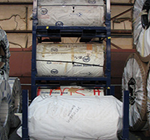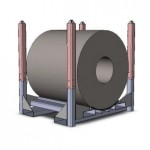6 Amazing Benefits of Warehouse Storage Solutions
A warehouse can become a chaotic place if the space is not used correctly. A well-designed warehouse storage solution helps keep your warehouse organized and capitalize on your space. Although many businesses have invested in warehouse storage solutions, many are still reluctant to invest in them. This post offers insights into the benefits of well-designed warehouse storage solutions.
Why Warehouse Storage Solutions is Important?
Efficient warehouse storage solutions are crucial for several reasons:
Improved Inventory Management: Proper storage solutions help you arrange inventory, making products more accessible and precisely accounted for. This decreases the likelihood of stockouts, overstocking, or misplacement of goods, resulting in increased customer satisfaction and fewer operational disruptions.
Enhanced Workflow and Productivity: Well-designed storage systems improve workflow efficiency by minimizing the time and effort necessary to find and retrieve goods. This increases overall productivity and operational efficiency, allowing warehouse employees to concentrate on value-added tasks rather than looking for goods.
Reduced Labor Costs: Efficient storage systems can reduce labor requirements for processes like picking, packing, and restocking. Automated storage systems and optimized layouts can eliminate the need for human handling, resulting in cheaper labor costs and enhanced worker safety.
Scalability and Adaptability: As businesses expand and adapt, their storage requirements may shift. Efficient storage systems are flexible and versatile, allowing facilities to adjust inventory levels and operational requirements without substantial disturbances.
Enhanced Safety: Efficient storage solutions help to provide a safer working environment in warehouses. By properly managing goods and implementing safety measures such as clear aisleways and secure storage systems, the chance of accidents and injuries can be decreased.
6 Benefits of Warehouse Storage Solutions
There are several benefits of investing in warehouse storage solutions like warehouse racks, pallets, and so on. The following are six popular ones among them.
- Optimizes Space: A warehouse racking designed with multiple storage tiers will help you optimize warehouse storage space. When industrial productions are at its peak, it is very common for manufacturers to invest in additional storage space. However, multiple storage tiers and forklift compatibility allows such manufacturers to optimize available space effectively.
- Cost-Effective Solution: If a warehouse is not organized correctly, then you may face difficulty in storing your industrial production. This will force you to look for another warehouse which will require extra expenditure. A well-organized warehouse is sufficient to store all your inventory, thus making it cost-effective.
- Less Time Consuming: A good warehouse storage solution helps manufacturers to manage time effectively. They can set racks and pallets as per LIFO and FIFO or any other inventory management technique to retrieve and deliver goods as required. This would help them manage inventory and save time.
- Improved Time-to-Market: When the inventory is organized for quick retrieval and effective movement, it helps manufacturers to improve their time-to-market capabilities. This time-to-market has emerged as a key growth differentiator in recent times.
- Cleanliness: Warehouse storage solutions not only help optimize the storage area of a warehouse but also keep it clean. After organizing the products precisely according to their size, the next step is to clean the remaining space. This will lend a lavish look to your warehouse and will help keep your inventory organized.
- Safety: Safety is the most crucial concern that should never be ignored. Considering the types of products and their weight, it is crucial to look after the safety of your warehouse, inventory, labor, machines, tools, and so on. An organized warehouse is always safe for all. You can use various storage racks, like pallet racks, for storing heavy inventory. Warehouse racking will help you in arranging a warehouse more precisely.
How Warehouse Storage Facilities Maximize Available Space
Warehouse storage facilities maximize available space through several strategies:
Vertical Storage: Utilizing vertical space by installing tall shelves, mezzanines, or multi-level racking systems allows warehouse storage facilities to store goods vertically rather than spreading them out horizontally. This strategy effectively increases storage capacity without expanding the warehouse’s footprint.
Selective Racking Systems: Selective racking systems, such as pallet racking, provide easy access to individual pallets while maximizing vertical space. By adjusting shelf heights and aisle widths to accommodate different types of inventory, warehouses can efficiently store a variety of goods.
Narrow Aisle Layouts: Narrow aisle configurations optimize floor space by reducing the width of aisles between storage racks. Narrow aisle forklifts or automated guided vehicles (AGVs) can navigate these aisles efficiently, allowing for dense storage while maintaining accessibility to inventory.
High-Density Storage Systems: High-density storage solutions, such as drive-in racks, push-back racks, or mobile shelving systems, are designed to maximize storage density by minimizing aisle space and allowing for deeper storage of goods. These systems are ideal for storing large quantities of homogeneous products.
Mezzanine Floors: Installing mezzanine floors creates additional levels within the warehouse, effectively doubling the available floor space. Mezzanines can be used for storage, offices, or work areas, depending on the warehouse’s needs.
Cross-Docking: Cross-docking involves transferring goods directly from inbound to outbound trucks without storing them in the warehouse. This strategy reduces the need for long-term storage space and minimizes inventory handling, freeing up space for other purposes.
Slotting Optimization: Slotting optimization involves strategically assigning storage locations based on factors such as item popularity, size, weight, and turnover rate. By placing fast-moving or high-demand items in easily accessible locations, warehouses can improve picking efficiency and maximize space utilization.
Utilization of Cubic Space: Instead of focusing solely on floor space, warehouses should also consider the cubic space available within their facilities. Using taller shelving and storage systems allows businesses to take advantage of the entire volume of the warehouse, not just the floor area.
Importance of Safety Considerations in Warehouse Storage Systems
Safety considerations in warehouse storage systems are paramount for several reasons:
Worker Safety: The primary concern in any warehouse environment is the safety of workers. Improperly designed or maintained storage systems can pose significant risks of accidents, such as items falling from shelves, collapsing racks, or forklift collisions. By prioritizing safety in storage system design and maintenance, warehouses can minimize the risk of injuries to their employees.
Prevention of Accidents: Proper safety measures in warehouse storage systems help prevent accidents that could result in injuries, damage to goods, or even fatalities. By implementing safety features such as guardrails, safety nets, and anti-collapse devices, warehouses can reduce the likelihood of accidents and create a safer working environment for everyone.
Protection of Inventory: Safety considerations in storage systems not only safeguard employees but also protect inventory from damage. Properly designed storage systems prevent items from falling or shifting, reducing the risk of product damage and minimizing financial losses for the business.
Compliance with Regulations: Warehouse operations are subject to various safety regulations and standards imposed by government agencies and industry organizations. Adhering to these regulations not only ensures the safety of workers but also helps warehouses avoid fines, penalties, and legal liabilities resulting from non-compliance.
Enhanced Productivity: A safe working environment promotes productivity by reducing the likelihood of accidents and injuries that could disrupt operations. When workers feel safe and secure, they are more focused, motivated, and efficient in their tasks, leading to improved productivity and operational performance.
Risk Management: Safety considerations in warehouse storage systems are integral to risk management efforts. Identifying potential hazards, implementing safety protocols, and regularly inspecting storage equipment help warehouses mitigate risks and prevent costly accidents or incidents.
Employee Morale and Retention: Prioritizing safety in warehouse operations demonstrates a commitment to employee well-being, which can boost morale and contribute to higher job satisfaction among workers. A positive safety culture also helps attract and retain talent, as employees are more likely to stay with companies that prioritize their safety.
Reputation and Brand Image: Safety incidents in warehouses can tarnish a company’s reputation and brand image, leading to loss of customer trust and business opportunities. On the other hand, a strong focus on safety demonstrates corporate responsibility and can enhance the company’s reputation among customers, suppliers, and the public.
Role of Warehouse Storage Equipment in Warehouse Storage Management
Warehouse storage equipment is indispensable for efficient warehouse storage management. Its roles encompass maximizing space utilization by employing pallet racks, mezzanine floors, and automated storage and retrieval systems (AS/RS) to optimize vertical and horizontal space. These equipment types also aid in organizing inventory systematically, facilitating easy access and retrieval based on factors like SKU, size, and turnover rate.
Moreover, storage equipment ensures inventory protection and safety through features such as beam guards and rack protectors, reducing the risk of workplace accidents. By enhancing accessibility and retrieval, equipment like conveyor systems and AS/RS streamline movement within the warehouse, minimizing manual labor and order fulfillment time.
Warehouse storage equipment also contributes to optimized workflow, with layout designs incorporating conveyors and picking stations to minimize travel time for workers. Additionally, it offers adaptability and scalability, allowing warehouses to adjust to changing storage needs and scale operations as required.
If you are an OEM and looking to set up your warehouse, you would require multiple racking systems or other safe and robust instruments for organizing your warehouse. Managing a warehouse is a one-time investment and does not require changes frequently. Therefore, it is essential to partner with a trusted and reliable provider of warehouse storage solutions. To come up with one, SPS Ideal Solutions is one of the leading providers of warehouse storage solutions like racks, pallets, and storage containers. You can get in touch with the experts at the company to discuss your warehouse storage requirements. The experts will help you choose the right solution for your warehouse.
Related Posts:
- https://www.spsidealsolutions.com/how-to-overcome-warehouse-challenges
- https://www.spsidealsolutions.com/how-to-calcuate-warehouse-storage-space
- https://www.spsidealsolutions.com/material-storage-products-for-your-warehouse
- https://www.spsidealsolutions.com/how-does-adjustable-pallet-racking-system-optimize-warehouse-storage-efficiency
About The Author













